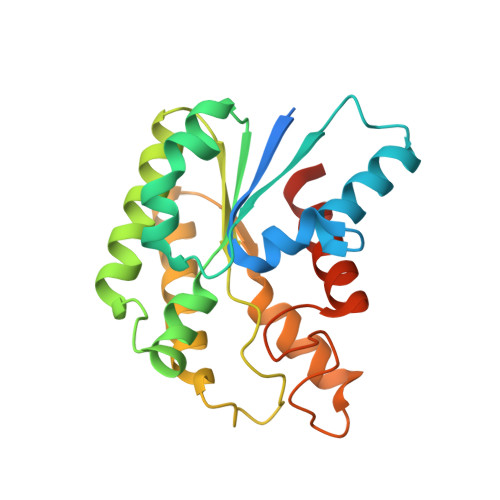Active site architecture of an acetyl xylan esterase indicates a novel cold adaptation strategy.
Zhang, Y., Ding, H.T., Jiang, W.X., Zhang, X., Cao, H.Y., Wang, J.P., Li, C.Y., Huang, F., Zhang, X.Y., Chen, X.L., Zhang, Y.Z., Li, P.Y.(2021) J Biol Chem 297: 100841-100841
- PubMed: 34058201
- DOI: https://doi.org/10.1016/j.jbc.2021.100841
- Primary Citation of Related Structures:
7DDY - PubMed Abstract:
SGNH-type acetyl xylan esterases (AcXEs) play important roles in marine and terrestrial xylan degradation, which are necessary for removing acetyl side groups from xylan. However, only a few cold-adapted AcXEs have been reported, and the underlying mechanisms for their cold adaptation are still unknown because of the lack of structural information. Here, a cold-adapted AcXE, AlAXEase, from the Arctic marine bacterium Arcticibacterium luteifluviistationis SM1504 T was characterized. AlAXEase could deacetylate xylooligosaccharides and xylan, which, together with its homologs, indicates a novel SGNH-type carbohydrate esterase family. AlAXEase showed the highest activity at 30 °C and retained over 70% activity at 0 °C but had unusual thermostability with a T m value of 56 °C. To explain the cold adaption mechanism of AlAXEase, we next solved its crystal structure. AlAXEase has similar noncovalent stabilizing interactions to its mesophilic counterpart at the monomer level and forms stable tetramers in solutions, which may explain its high thermostability. However, a long loop containing the catalytic residues Asp200 and His203 in AlAXEase was found to be flexible because of the reduced stabilizing hydrophobic interactions and increased destabilizing asparagine and lysine residues, leading to a highly flexible active site. Structural and enzyme kinetic analyses combined with molecular dynamics simulations at different temperatures revealed that the flexible catalytic loop contributes to the cold adaptation of AlAXEase by modulating the distance between the catalytic His203 in this loop and the nucleophilic Ser32. This study reveals a new cold adaption strategy adopted by the thermostable AlAXEase, shedding light on the cold adaption mechanisms of AcXEs.
Organizational Affiliation:
State Key Laboratory of Microbial Technology, Shandong University, Qingdao, China; College of Marine Life Sciences, and Frontiers Science Center for Deep Ocean Multispheres and Earth System, Ocean University of China, Qingdao, China; Laboratory for Marine Biology and Biotechnology, Pilot National Laboratory for Marine Science and Technology, Qingdao, China.














